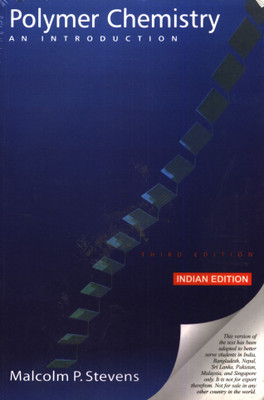POLYMER CHEMISTRY, 3/E 3rd Edition(English, Paperback, Malcolm P Stevens)
Quick Overview
Product Price Comparison
Polymer Chemistry Is An Introductory Textbook Intended For Graduate And Advanced Undergraduate Students And Industrial Chemists Who Work With Polymers. The Author'S Purpose In Writing The Book Was To Provide A Comprehensive And Up-To-Date Overview Of The Chemistry Of Macromolecular Substances, With Particular Emphasis On Polymers That Are Important Commercially, And The Properties That Make Them Important. Major Topics Include Polymer Synthesis Nomenclature, Molecular Weight, Reactions Of Polymers, Recycling Of Polymers, Methods Used For Characterizing And Testing Polymers, Morphology, Stereoregular Polymers, Polymer Blends, Heterocyclic Polymers, Inorganic Polymers, And Natural Polymers. Review Exercises, Frequently Including Journal References, Are Provided To Lead Students Into The Polymer Literature. Key Features The Only Polymer Textbook That Discusses Polymer Types According To Functional Group. The Most Up-To-Date Treatment Of Important New Developments, Including Living Free Radical Polymerization, Metallocene Initiators For Polyofins, New Polymer Architectures Such As Dendritic And Hyperbranched Polymers, Atomic Force Microscopy, And Mass Spectrometric Methods For Determining Molecular Weights Of Polymers. About The Author Malcolm P. Stevens ,Professor Of Chemistry, University Of Hartford Table Of Contents Part I. Polymer Structure And Properties 1. Basic Principles 2. Molecular Weight And Polymer Solutions 3. Chemical Structure And Polymer Morphology 4. Chemical Structure And Polymer Properties 5. Evaluation, Characterization, And Analysis Of Polymers Part Ii. Vinyl Polymers 6. Free Radical Polymerization 7. Ionic Polymerization 8. Vinyl Polymerization With Complex Coordination Catalysts 9. Reactions Of Vinyl Polymers Part Iii. Nonvinyl Polymers 10. Step-Reaction And Ring-Opening Polymerization 11. Polyethers, Polysulfides, And Related Polymers 12. Polyesters 13. Polyamides And Related Polymers 14. Phenol-, Urea-, And Melamine-Formaldehyde Polymers 15. Heterocyclic Polymers 16. Inorganic And Partially Inorganic Polymers 17. Miscellaneous Organic Polymers 18. Natural Polymers Appendix A. Commonly Used Polymer Abbreviations Appendix B. Polymer Literature Appendix C. Sources Of Laboratory Experiments In Polymer Chemistry Index


